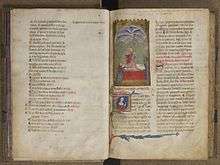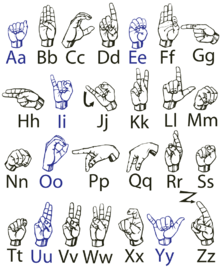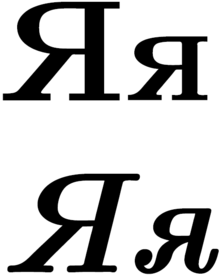Letter (alphabet)

A letter is a grapheme (written character) in an alphabetic system of writing, such as the Greek alphabet and its descendants. Letters also appear in abjads and abugidas (variants of alphabets in which vowel marking is secondary or absent). Letters broadly denote phonemes in the spoken form of the language, although there is rarely a consistent exact correspondence between letters and phonemes.
Written signs in other writing systems are best called syllabograms (which denote a syllable) or logograms (which denote a word or phrase).
Definition and usage
"Letter," borrowed from Old French lettre, entered Middle English around AD 1200, eventually displacing the native English term bocstaf (i.e. bookstaff). Letter derives from Latin littera, which may have derived, via Etruscan, from the Greek "διφθέρα" (writing tablet).[1] The Middle English plural lettres could refer to an epistle or written document, reflecting the use of the Latin plural litteræ. Use of the singular letter to refer to a written document emerged in the 14th century.
As symbols that denote segmental speech, letters are associated with phonetics. In a purely phonemic alphabet, a single phoneme is denoted by a single letter, but in history and practice letters often denote more than one phoneme. A pair of letters designating a single phoneme is called a digraph. Examples of digraphs in English include "ch", "sh" and "th". A phoneme can also be represented by three letters, called a trigraph. An example is the combination "sch" in German.
A letter may also be associated with more than one phoneme, with the phoneme depending on the surrounding letters or etymology of the word. As an example of positional effects, the Spanish letter c is pronounced [k] before a, o, or u (e.g. cantar, corto, cuidado), but is pronounced [θ] before e or i (e.g. centimo, ciudad).
Letters also have specific names associated with them. These names may differ with language, dialect and history. Z, for example, is usually called zed in all English-speaking countries except the U.S., where it is named zee.
Letters, as elements of alphabets, have prescribed orders. This may generally be known as "alphabetical order" though collation is the science devoted to the complex task of ordering and sorting of letters and words in different languages. In Spanish, for instance, ñ is a separate letter being sorted after n. In English, n and ñ are sorted alike.
Letters may also have numerical value. This is true of Roman numerals and the letters of other writing systems. In English, Arabic numerals are typically used instead of letters.
Letters may be used as words. The words a (lower or uppercase) and I (always uppercase) are the most common English letter-words. Sometimes O is used for "Oh" in poetic situations. In extremely informal cases of writing (such as SMS language) individual letters may replace words, e.g. u may be used instead of "you" in English, when the letter name is pronounced as a homophone of the word.
People and objects are sometimes named after letters, for one of these reasons:
- The letter is an abbreviation, e.g. "G-man" as slang for a Federal Bureau of Investigation agent, arose as short for "Government Man".
- Alphabetical order used as a counting system, e.g. Plan A, Plan B, etc.; alpha ray, beta ray, gamma ray, delta ray, epsilon ray
- The shape of the letter, e.g. D-ring, F-clamp, G-clamp, H-block, H engine, O-ring, R-clip, U engine, V engine, Z-drive, a river delta
- Other reasons, e.g. X-ray after "x the unknown" in algebra, because the discoverer did not know what they were.
A classical definition

Guilhem Molinier, a member of the Consistori del Gay Saber, which was the first literary academy in the world and held the Floral Games to award the best troubadour with the violeta d'aur top prize, gave a definition of the letter in his Leys d'Amors (1328–1337), a book aimed at regulating the then flourishing Occitan poetry:
|
Letra votz no es devisabla. E per escriure convenabla. Letra per miels esser exposta. Es menor part de votz composta. |
A letter is an indivisible sound That is fit for writing; A letter, to define it better, Is the smallest part of a composite sound. |
History
The first consonantal alphabet found has emerged around 2000 BCE to represent the language of Semitic workers in Egypt (see Middle Bronze Age alphabets), and was derived from the alphabetic principles of the Egyptian hieroglyphs. Nearly all alphabets in the world today either descend directly from this development or were inspired by its design.[2] The Greek alphabet, invented around 800 BCE, was the first alphabet assigning letters not only to consonants, but also to vowels.[3]
Types of letters

Various scripts
The following alphabets, abjads, and individual letters are discussed in related articles. Each represents a different script:
Bangla alphabet:অ, আ, ই, ঈ, উ, ঊ, ঋ, এ, ঐ, ও, ঔ, ক, খ, গ, ঘ, ঙ, চ, ছ, জ, ঝ, ঞ, ট, ঠ, ড, ঢ, ণ, ত, থ, দ, ধ, ন, প, ফ, ব, ভ, ম, য, ৰ, ল, ৱ, শ, ষ, স, হ, ড়, ঢ়, য়, ৎ, ং, ঃ, ঁ
Arabic alphabet: (Alphabetical from right to left) ﺍ, ﺏ, ﺕ, ﺙ, ﺝ, ﺡ, ﺥ, ﺩ, ﺫ, ﺭ, ﺯ, ﺱ, ﺵ, ﺹ, ﺽ, ﻁ, ﻅ, ﻉ, ﻍ, ﻑ, ﻕ, ﻙ, ﻝ, ﻡ, ﻥ, هـ, ﻭ, ﻱ.
Syriac alphabet: (Alphabetical from right to left) ܐ, ܒ, ܓ, ܕ, ܗ, ܘ, ܙ, ܚ, ܛ, ܝ, ܟܟ, ܠ, ܡܡ, ܢܢ, ܣ, ܥ, ܦ, ܨ, ܩ, ܪ, ܫ, ܬ.
Cyrillic script: А, Б, В, Г, Ґ, Ѓ, Д, Е, Є, Ж, З, Ѕ, И, І, Ї, Й, К, Ќ, Л, М, Н, О, П, Р, С, Т, У, Ф, Х, Ц, Ч, Ш, Щ, Ю, Я, Ъ, Ь, Ђ, Љ, Њ, Ћ, Џ, Ы.
Georgian script: ა, ბ, გ, დ, ე, ვ, ზ, თ, ი, კ, ლ, მ, ნ, ო, პ, ჟ, რ, ს, ტ, უ, ფ, ქ, ღ, ყ, შ, ჩ, ც, ძ, წ, ჭ, ხ, ჯ, ჰ
Greek alphabet: Α, Β, Γ, Δ, Ε, Ζ, Η, Θ, Ι, Κ, Λ, Μ, Ν, Ξ, Ο, Π, Ρ, Σ, Τ, Υ, Φ, Χ, Ψ, Ω.
Hebrew alphabet: (Alphabetical from right to left) א, ב, ג, ד, ה, ו, ז, ח, ט, י, כ, ל, מ, נ, ס, ע, פ, צ, ק, ר, ש, ת.
English alphabet: A, B, C, D, E, F, G, H, I, J, K, L, M, N, O, P, Q, R, S, T, U, V, W, X, Y, Z.
Hangul: ㄱ ㄲ ㄴ ㄷ ㄸ ㄹ ㅁ ㅂ ㅃ ㅅ ㅆ ㅇ ㅈ ㅉ ㅊ ㅋ ㅌ ㅍ ㅎ ㅏ ㅐ ㅑ ㅒ ㅓ ㅔ ㅕ ㅖ ㅗ ㅘ ㅙ ㅚ ㅛ ㅜ ㅝ ㅞ ㅟ ㅠ ㅡ ㅢ ㅣ
Bopomofo: ㄅ ㄆ ㄇ ㄈ ㄉ ㄊ ㄋ ㄌ ㄍ ㄎ ㄏ ㄐ ㄑ ㄒ ㄓ ㄔ ㄕ ㄖ ㄗ ㄘ ㄙ ㄚ ㄛ ㄜ ㄝ ㄞ ㄟ ㄠ ㄡ ㄢ ㄣ ㄤ ㄥ ㄦ ㄧ ㄨ ㄩ ㄭ
Ogham: ᚁ ᚂ ᚃ ᚄ ᚅ ᚆ ᚇ ᚈ ᚉ ᚊ ᚋ ᚌ ᚍ ᚎ ᚏ ᚐ ᚑ ᚒ ᚓ ᚔ ᚕ ᚖ ᚗ ᚘ ᚙ ᚚ ᚛ ᚜
Ethiopic ሀ ለ ሐ መ ሠ ረ ሰ ቀ በ ተ ኀ ነ አ ከ ወ ዐ ዘ የ ደ ገ ጠ ጰ ጸ ፀ ፈ ፐ
International Phonetic Alphabet - used to represent exact pronunciation
For other writing systems and their letters, see List of writing systems.
Upper and lower case
Some writing systems have two major forms for each letter: an upper case form (also called capital or majuscule) and a lower case form (also called minuscule). Upper and lower case forms represent the same sound, but serve different functions in writing. Capital letters are most often used at the beginning of a sentence, as the first letter of a proper name, or in inscriptions or headers. They may also serve other functions, such as in the German language where all nouns begin with capital letters.
Typeface and font
A letter may be printed in a number of different sizes or forms, depending on choice of typeface. A typeface is a single, stylistically consistent set of forms for letters (or glyphs). A particular typeface may alter standard forms of characters, may present them with different optical weight, or may angle or embellish their forms. A font is more specific than a typeface, since it specifies the size of the letters as well as the form.
In calligraphy, letters are written artistically and may or may not be consistent throughout a work.
Letter frequencies
The average distribution of letters, or the relative frequency of each letter's occurrence in text in a given language can be obtained analyzing large amounts of representative text. This information can be useful in cryptography and for other purposes as well. Letter frequencies vary in different types of writing. In English, the most frequently appearing ten letters are e, t, a, o, i, n, s, h, r, and d, in that order, with the letter e appearing about 13% of the time.
Footnotes
- ↑ http://www.etymonline.com/index.php?term=letter&allowed_in_frame=0
- ↑ Himelfarb, Elizabeth J. "First Alphabet Found in Egypt", Archaeology 53, Issue 1 (Jan./Feb. 2000): 21.
- ↑ Millard 1986, p. 396
See also
- Abecedarium
- Artificial script
- Character (computing)
- Collation
- Diacritic
- Digraph (orthography)
- Glyph
- Grapheme
- Greek letters used in mathematics
- History of the alphabet
- Letterform
- Ligature
- Orthography
- Roman letters used in mathematics
- Typeface
- Typography
- Unicode
Sources
- Millard, A. R. (1986), "The Infancy of the Alphabet", World Archaeology, 17 (3): 390–398, doi:10.1080/00438243.1986.9979978
References
- Daniels, Peter T., and William Bright, eds 1996. The World's Writing Systems. ISBN 0-19-507993-0.
- Powell, Barry B. 1991. Homer and the Origin of the Greek Alphabet. ISBN 978-0-521-58907-9 | ISBN 0-521-58907-X.
- Robinson A. 2003, "The Origins of writing" in David Crowely and Paul Heyer 'Communication in History: Technology, Culture, Society' (fourth edition) Allyn and Bacon Boston pp 34–40
| Wikimedia Commons has media related to Letters. |
External links
| Look up letter, bookstaff, or bookstave in Wiktionary, the free dictionary. |
